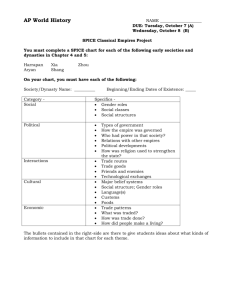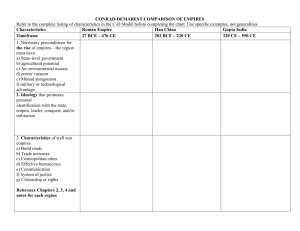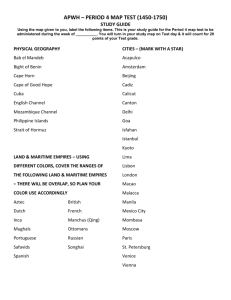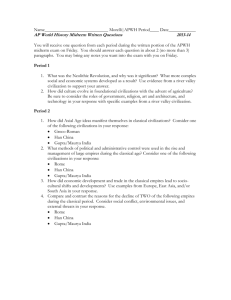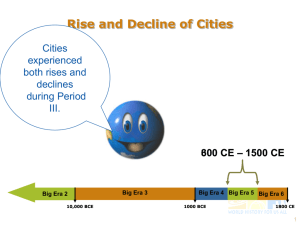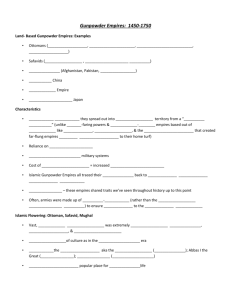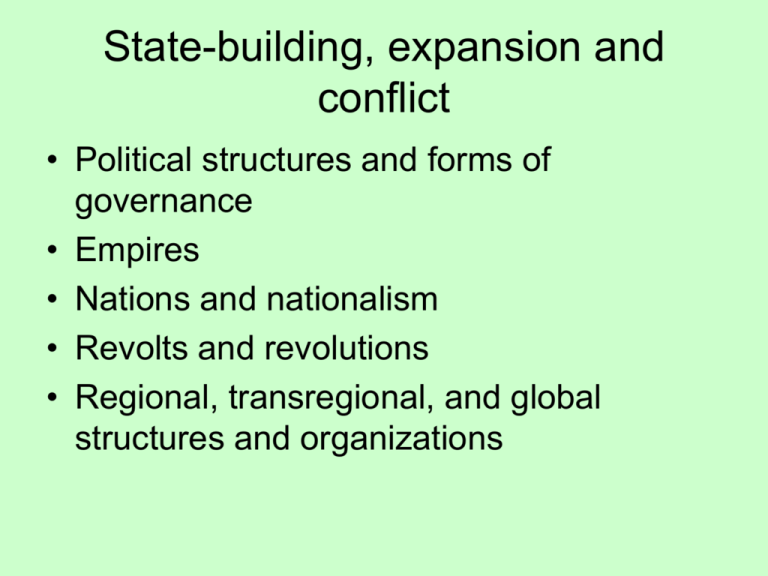
State-building, expansion and
conflict
• Political structures and forms of
governance
• Empires
• Nations and nationalism
• Revolts and revolutions
• Regional, transregional, and global
structures and organizations
Features at the Beginning of Period 1
• no organized political
units, cities, or states
• largest community of
humans were H-G
bands, 30-50 people
Key Continuities
• unequal treatment favored elites
• rulers/elites often claimed divinity or divine support
(Egypt, China)
Key Changes
• codification of laws (Hammurabi, Manu)
– Dynastic system emerges
• Core civilizations developed where agriculture flourished:
– 1st states emerged within core civilizations: replaced
city-states, kept power by maintaining strong military,
Early empires emerge: Sargon the Great, Hammurabi
– codification of laws (Hammurabi, Manu)
Characteristics at the End of Period 2
• Empires & Civs: Sumeria, Akkadia, Egypt,
Nubia, Olmec, Shang, Zhou, Bantus, Greece,
Maurya
Reasons for the continuities or changes
• increase in pop →need to organize, control, & coordinate
populations
• Needed to organize and oversee the fabrication of roads,
irrigation projects, public buildings, etc. and to regulate
commerce (through the establishment of laws, courts,
and a system of punishment.
• Needed to protect citizens from invasions and to organize
attacks on rival civilizations
Domestication of Plants and Animals
Farming
Population
Intensification
Surplus Food
Specialization
Complex Society,
also known as
CIVILIZATION
Big Eras 4-9
Big Era 2
Big Era 3
10,000 years ago
1,000 years ago
Today
5
That translates into:
Farmers
Herders
Cities
Central governments
Armies
Monumental buildings
Written language
Social hierarchies
Complex belief systems
In 10,000 BCE none of these existed in the world. By 1,000 BCE they
all did.
6
Key Concept 1.3:
Core Civilizations
The Development and
Interactions of Early
Agricultural, Pastoral and
Urban Societies.
CORE/FOUNDATIONAL RIVER
CIVILIZATIONS
Core and foundational civilizations developed
in a variety of geographical and environmental
settings where agriculture flourished.
• Mesopotamia in the Tigris and Euphrates River
Valleys
• Egypt in the Nile River Valley
• Mohenjo-Daro and Harappa in the Indus River
Valley
• Shang in the Yellow River or Huang He Valley
• Olmecs in Mesoamerica
• Chavín in Andean South America
Mesopotamia in the Tigris and Euphrates River
Valleys
(c.4000 BCE-2330 BCE)
Egypt in the Nile River Valley
(c.3100 BCE-1070 BCE)
Mohenjo-Daro and Harappa in the Indus
River Valley
(c.3000 BCE-1500 BCE)
Shang in the Yellow River or Huang He
Valley
(c.1750 BCE-1122 BCE)
Olmecs in Mesoamerica
(c.1200 BCE-400 BCE)
Chavín in Andean South America
(c.900 BCE-200 BCE)
The first states emerged within
core civilizations.
• Power new states replaced city-states as
main political unit.
• Rulers were viewed as divine.
• Kept power by maintaining a strong
military.
• Competition between city-states and
nomads lead to an increase in conflict!
Examples of early empires.
• Sargon the Great: Built
first empire c. 2340 BCE.
• Hammurabi: King of
Babylon c.1792 BCE
*** Towards the end of this
period, you have several
more fierce empires such
as, the Assyrians and
Persians c. 6th and 7th
Century BCE.
*** Why so much conflict in
this region
(Mesopotamia)?
Read The Assyrian Military Machine
p.30
• What did Assyrian kings believe was
important for military success?
• Do you think their accounts may be
exaggerated? Why?
POLITICAL AND MILITARY
STRUCTURE
• Pastoralists (nomadic
herders) interact quite
often with “urban
societies”
• 2 examples would be
through new weapons
and modes of
transportation.
• Examples: Iron
weapons and chariots
• What would the effect
be on “settled
societies”?
Systems of Record Keeping
• Eventually would branch out to include
other forms of “writing”.
• Examples:
- cuneiform – Mesopotamia
- hieroglyphs – Egypt
- alphabets – Phoenicia
- quipu – the Inca
Legal Codes
• States would eventually use writing to
develop legal codes.
• Often reflected existing hierarchies and
helped the government rule over the
people.
The Code of Hammurabi
• Read the Code of
Hammurabi excerpt
on p. 13 in the Duiker
book.
• What do these points
of law from the Code
of Hammurabi reveal
to you about
Mesopotamian
society?
With the development of
farming and cities, political
organization became much
more complex.
Why?
Egypt and the Shang in China were highly
centralized. They developed bureaucracies,
dynasties, and used religion to justify the
position of the rulers.
Features at the Beginning of Period 2
Empires & Civilizations: Olmec,
Egypt, Zhou, Greece, Bantus,
Maurya Assyrians, Persians
Competition between city-states
and nomadic herders lead to
increased conflict
Key Continuities
• rulers often claimed divinity / support
• military threats from “outsiders”
Key Changes
• # & size of states grew dramatically
• administrative techniques (bureaucracies,
legal systems, diplomacy)
Characteristics at the End of Period 2
• Empires: Large, Regional in Size (Byzantium,
Gupta, Han, Maya, Nazca, Persia, Rome,
Toltec)
• established administrative bureaucracies, large
public works projects, legal codes, currency
Reasons for the continuities or changes
• empires grew beyond their ability to administer
• tech of the day limited imperial administration,
communication, control
Expanding Networks:
Empires
Empires had formed in Afroeurasia as
early as Period 1. Although many
claimed vast territories, most did not
survive for long.
In the 4th century BCE, Alexander the
Great amassed an empire that
stretched from Greece to India. Upon
his death, however, the empire
fragmented.
The later centuries of Big Era Four
saw the rise of new empires that both
dominated huge expanses of land and
remained unified for a long time. The
Largest of these were the Han and
Roman empires.
Large Empires of Afroeurasia
500 BCE - 500 CE
Rome Byzantium
Kush
Axum
Kushana
Parthian/
Sassanid
Maurya/
Gupta
Xiongnu
Han
Classical empires were much more complex because they were so large.
They had to invent new ways to keep their land together.
How did the classical empires accomplish this?
Rome: At first a republic ruled by aristocrats w/ some
shared power with the Senate and 2 consuls usually selected
military. Later, an empire with focus on
military conquest, colonization, and law codes.
The ideal was to use principle of the rule of law; not the
rule by the whim of the emperor.
China:
Mandate of Heaven, the emperor
was the Sun of Heaven housed in
the Forbidden City.
Yellow Turban Revolt
from t
What causes regionalism?
Mauryan and Gupta gain power through the
military.
The greatest of the Mauryan kings
was? Why?
Meanwhile, in Africa, the Bantu-based
societies and others developed
stateless societies which were
A. centralized.
B. decentralized.
How do you know?
Post-Classical World 600-1450
Theme
1.
Statebuilding,
expansion
and
conflict
Basic Features at
Beginning of Period
Key Continuities
Key changes
• Empires: Large,
Regional in Size
• traditional symbols &
methods of power &
legitimacy (temples,
(Maya, Byzantium,
Umayyad, Gupta, Tang) patriarchy)
• political diffusion
• established
(political ideas from one
administrative
empire to another)
bureaucracies
• privilege of elites over
lower classes
• new methods of
managing empires: citystates (E Africa),
sultanate
(Ottoman, Delhi)
• caliphate &
caesaropapism combined
political & religious
authority
Basic Features at
End of Period
• Regional and TransRegional Empires
(Mongols, Delhi,
Ottomans, Ming, Aztec)
• traditional & new
administrative
techniques
Reasons for
Change or
Continuities
• larger empires
→cult diffusion
• admin
methods →
larger empires
Vikings
Population
Mongols
Germanic
Tribes
Turkic
Groups
Chinese
Arabs
Bantu-Speaking
People of Africa
People migrated to new
places in (and out) of
Afroeurasia.
People of
Oceania
35
Empires
Building states and
empires involved
cultural exchanges
in Afroeurasia.
During Period 3,
many, many states
and empires came…
and went.
36
Empires
New ruling groups
built on the
foundations of
earlier states and
empires.
37
Frankish
Kingdoms
Avar Kingdom
Parhae
Byzantine Empire
Sassanid
Empire
Sui China
Silla
Yamoto
Japan
Harsha’ Empire
Chalukya
Ghana
Axum
States and Empires in 600 CE
38
Carolingian
Parhae
Byzantine
Cordoba
Caliphate
Abbasid
Caliphate
GurjaraPratihara
Tang China
Silla
Heian
Japan
Ghana
Axum
Srivijaya
States and Empires in 800 CE
39
Scandanavian
Kingdoms
Russia
England
France
Spain
H.R.E.
Poland
Mongol Empire
Hungary
Rum
Portugal Almohad
Caliphate Ayyubid
Caliphate
Koryo
Delhi
Sultanate
Sung
China
Kamakura
Japan
Mali
Ethiopia
Oyo
Angkor
Benin
Zimbabwe
States and Empires in 1237 CE
40
Union of Kalmar
Russian
States
Scotland
England
France
Portugal
PolandKhanate of the
Holy
Lithuania Golden Horde
Roman
Empire Hungary
Castile
Jagatai
Khanate
Ottoman Emp.
Timurid Empire
Granada
Marinids Hafsids
Korea
Ming
China
Ashikaga
Japan
Mamluk
Sultanate
Mali
Oyo Benin
Ethiopia
Vijayanagara
Zanj City-States
Siam
Majapahit
Zimbabwe
States and Empires in 1400 CE
41
Empires
How did states
and empires
stimulate
cultural
exchanges in
Afroeurasia?
• Wars led to
destruction but
produced new
inventions.
• Strong governments
protected trade
routes and stabilized
currencies.
• Royal courts were
patrons of science,
religious institutions,
and arts.
• Large states brought
together many
ethnic, language, and
religious groups.
42
Trade
Trade was also
closely linked to
cultural exchange.
Empires
supported trade in
Afroeurasia.
Merchants
traveled great
distances in
search of wealth.
43
Trade
The number of cities grew, as
well as trade networks between
them.
44
Trade
Microsoft®Encarta®Reference Library 2002. ©1993-2001 Microsoft Corporation. All rights
reserved.
From 300-1500 CE, trade routes extended
farther and were used by more travelers.
45
WEST AFRICA
•
•
•
•
Ghana and Mali
Became rich by taxing traders
Powerful military (see a pattern here?)
Mali first major leader Sundiata and later
Mansa Musa
Islamic Empires
• After Muhammad’s death, the government
set up rule by a Caliph.
• Abu Bakr was the first caliph supported by
well-trained armies
• Aided by the weaknesses of the Persian
and Byzantine empires
Pastoral nomads which means they are a _________ ___________?
“Protect trade routes.” Sounds familiar doesn’t it?
Organized into regional Khanates which were politically controlled by a relative
with one main ruler known as the Great Khan.
TANG AND SONG DYNASTIES
TANG AND SONG DYNASTIES
• Equal–field system
• Strong support for
transportation and
communication
• Meritocracy
• Religion played a role
• Took tribute from their
neighbors
• Hegemony over
neighbors
• Expanded
meritocracy
• Didn’t emphasize the
military as much so
not as much
hegemony
• Trade,
communication and
transportation still
important
YUAN Dynasty ruled by collecting tribute called
Tax Farming. This outsourcing of tax collection
led to corruption and rebellion and ultimately to
their downfall.
Who really had the power in
Japan?
What do these names have in
common?
Fujiwara, Minamoto, Tokugawa
The feudal system was less centralized than some areas, but more
powerful than a local government. Political values emphasized what?
European Feudalism established political and military relationships.
Byzantium
Justinian law codes the biggest legacy.
The ruler was absolute in power and controlled the
church as well.
Russia
Copied Justinian law codes and organized into a state
by the 10thc. in Kiev.
States and
Empires in the
Americas in
1500 CE
Aztec Empire
Mayan States
Inca Empire
Microsoft®Encarta®Reference Library 2002.
©1993-2001 Microsoft Corporation. All rights reserved.
54
THE AMERICAS
• Maya: city-states w/ no central govt.
• Aztecs: central monarch in Tenochtitlan
who didn’t have absolute power; a council
of aristocrats made many decisions; no
elaborate bureaucracy
• Inca: highly powerful centralized govt. the
Inca owned all of the land; elaborate
bureaucracy; road system enforced Inca’s
power; quipu kept records
1450-1750
Power of nomads decreased because of sea trade’s rising importance.
Major maritime powers were?
Major Gunpowder Empires were?
THE GREAT GLOBAL CONVERGENCE
Theme
1.
State-building,
expansion and
conflict (political
structures &
forms of
governance,
empires,
nations &
nationalism,
revolts,
revolution)
Basic Features at
Beginning of Period
Key Continuities
Key changes
• Regional and
Trans- Regional
Empires (Mongols,
Delhi, Ottomans,
Ming, Aztec)
• land-based
empires (Ottoman,
Ming/Qing,
Sultanate of Delhi,
Mughal, Russia)
• traditional & new
administrative
techniques
• sea based empires
(Portugal, Spain,
Netherlands, Great
Britain)
• European
hegemony →
Americas
(Asia)
Basic Features at
End of Period
• increased
complexity &
competition
• minorities used for
econ profit
(pol rights)
Reasons for
Change or
Continuities
• global
economy →
increased
competition
• global size
→ gov’t
complexity
(Samurai,
Ming,
scholarbureaucrats,
Ottoman
devshirme)
Asian commercial and political
voyages on the seas continued.
Indian Ocean trade
routes attracted
merchants as they had
for centuries.
Zheng He, Admiral
of the Ming fleet,
made seven
voyages around the
Indian Ocean.
Ottoman naval vessels patrolled
the Mediterranean, the Black
Sea, and the Indian Ocean.
58
Technologies from Afroeurasia led to new
European ship designs in the 15th century.
Arab
lateen sail
Chinese
compass
Muslim portolan
charts and maps
Chinese
sternpost
rudder
59
Columbus
1492
Vasco da
Gama
1498
Magellan
1519
After 1415, European mariners made voyages
across the seas toward east and west. By 1519,
Spanish ships had circumnavigated the globe.
60
Others set out in search of wealth and adventure.
Spanish conquistadors ended Aztec and Inca rule
and claimed their lands in Mesoamerica and
Andean South America.
Aztec
Empire
Mayan
States
In 1492, two
major empires
in the Americas,
the Aztecs and
the Inca, ruled
many people.
Inca
Empire
61
Trade &
Manufacturing
Banking and law served new
demands.
• Accountants learned double-entry
bookkeeping with “Arabic” numerals.
• Commercial law protected private
property and investments.
• More efficient bureaucracies and
taxation increased the power of the
government’s purse.
• European monarchs issued charters to
colonize overseas.
• Jurists experimented with civil and
constitutional law.
62
States &
Empires
Period 4
was the
first age of
global
empires.
Large bureaucratic
states in Afroeurasia
used gunpowder and
artillery to expand
trade and win
territory in several
parts of Afroeurasia.
63
States &
Empires
Gunpowder empires in
Asia, Africa, and
Europe honed skills in
production of artillery
and handguns.
Land and maritime
empires battled over
control of trade,
resources, and
territory.
Persian, Indian, Turkish,
Chinese, Japanese, and
European artisans
experimented with steel
production for weapons.
64
States and Empires in 1519 CE
States &
Empires
65
States and Empires in 1600 CE
States &
Empires
66
States and Empires in 1714 CE
States &
Empires
67
States and Empires in 1804 CE
States &
Empires
68
Monarchs claimed
absolute power.
States &
Empires
Philip II
Spain
1556-1598
Süleyman
Ottoman Empire
1520-1566
Elizabeth I
England
1558-1603
Xizong
Ming China
1620-1627
Louis XIV
France
1643-1715
Shah Abbas
Persia
1587-1629
Catherine the Great
Russia
1762-1796
Jahangir
69
India
1605-1627
Challenges to absolutism came from new
elites with ideas about human rights.
States &
Empires
Charles I
1625-1649
King George III
1760-1820
Charles I, beheaded in 1649
Rebellion in American
Colonies 1776
Louis XVI
1775-1793
70
French Revolution
1789
Summary: global convergence led to
accelerating world change.
•World trade volume increased dramatically and
began to shift its center from Asia to the Atlantic
region.
•States increased their power with gunpowder
conquests and new sources of mercantile wealth.
•In Europe rising economic elites enjoyed growing
wealth, which led them to challenge old landed
aristocracies and monarchs.
71
The Ming defeat the Yuan.
Establish trade and bureaucracy again!
Send out trade expeditions to start collecting tribute again!
Afraid of another invasion from the North and West…again!
Begin to isolate themselves, because Confucian bureaucrats
were xenophobic.
Suffered from inept rulers who were isolated from the empire in the
Forbidden City….again!
Invaded by outsiders…again!
Manchu take the name Qing…used Mandate of Heaven to justify…
again!
WESTERN EUROPE
The pope remained politically powerful. Treaty of Tordesillas!
Kings begin to shake off feudalism and become more centralized by
taking on absolutism.
In Spain and Portugal they support exploration. Name those kings!
Later, so do France and England.
Magna Carta 1215 listed the rights
of the nobility and created
Parliament.
King Henry VIII Church and takes
over the monasteries separates
from the Catholic church.
Elizabeth I defeats the Spanish
Armada.
After the English Civil War the power of the king is
limited by the….of 1688
It greatly limited the power of the king AND allowed
wealthier merchants to participate in the government
Louis XIV said, “L’stat c’est moi!”
I AM THE STATE!
Absolutely!
Kings were not gods, but they were
His lieutenants on earth.
He greatly weakened the power of the
nobles and the feudal system.
Absolutists
• Russia and Peter the
Great
• Wanted to westernize
• Reformed military and
created the navy
• Reorganized
bureaucracy/took
titles away from
nobles
• Ottoman Empire
under Suleyman the
Magnificent (sultan)
• Used captured
Christian boys as
skilled soldiers and
bureaucratsJanissaries
• Grand Vizier
Colonies in the New World
• Spain and Portugal
• Developed large
bureaucracies in
urban areas
• Brought concepts of
feudalism and
absolutism with them
• English colonies had
no bureaucracies
• Colonists et up their
own structures like
representative bodies
and ran their own
affairs…salutary
neglect

